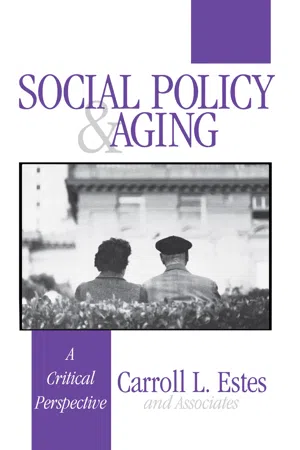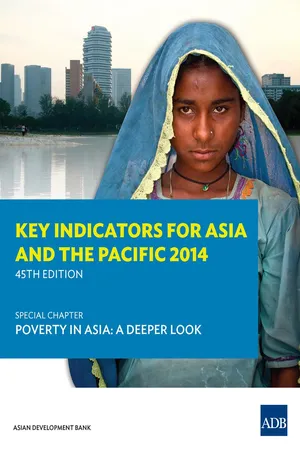Geography
Dependency Ratio
The dependency ratio is a demographic measure that compares the size of the economically dependent population (children and elderly) to the working-age population. It provides insight into the potential burden on the working population to support dependents. A high dependency ratio can strain social welfare systems and economic productivity, while a low ratio may indicate a more favorable demographic structure.
Written by Perlego with AI-assistance
Related key terms
5 Key excerpts on "Dependency Ratio"
- eBook - ePub
The Social Context of Ageing
A Textbook of Gerontology
- Christina Victor(Author)
- 2004(Publication Date)
- Routledge(Publisher)
Although there is often intense political debate about what the 'correct' age distribution for any given population should be, there is no easy answer. Interpretations of the implications of the different types of population distribution are rarely evidence based or value free. Each of these types of population distribution illustrated by Figures 4.1a and 4.1c, a projected distribution for twenty years hence, poses social and public policy challenges. The 1901 type of distribution implies lots of children, large families and high death rates. The major focus for public policy would be around child-related services (schools and child-maternal health) and reducing mortality and improving public health. The 'beehive' distribution suggests that caring for older people would be the major challenge for public policy. Based upon current age distributions we can make limited predictions about the likely nature and characteristics of the population in the future. For example, we can see that one of the most significant influences upon the structure of the British population will be the 'ageing' of the baby boomer generation (Evandrou, 1997). This mirrors the profound influence this group has had at earlier phases of the lifecycle and is not something unique to later life, although it is sometimes presented as such.Dependency Ratio
Another numerical, rather than visual, way of summarising the structure of a given population is via the use of the Dependency Ratio. This refers to the measures which express the 'dependent' population, defined as those not considered to be potentially active in the labour market, as a percentage of the population classed as not being dependent on or in relation to the overall total population. It is customary to calculate two distinct measures. One is concerned with children and is termed the 'youth Dependency Ratio' and the second is concerned with older people. In each the number in the population aged 0–15 (the age range which approximates to childhood) or 60/65 (the current ages for British women and men to become eligible for retirement pension) is expressed as a ratio (usually per 1000) percentage of those classified as economically active (i.e. 16–59/64) or as a ratio of the total population. Clearly there are many assumptions which underpin these measures and such assumptions should be explicitly stated and subject to critical analysis. The major assumptions are (a) all children are economically dependent (which ignores the participation of many in these age groups in part-time employment), (b) all those aged 16–59/64 are economically active (which ignores the early retirement of men from the labour market, the non-participation of women resultant from caring responsibilities or participation of young adults in higher education), (c) it is a single point in time, cross-sectional snapshot-type measure which ignores the previous contributions of older people. While these can be useful ways of summarising population structures we must be wary of the ideological assumptions which underpin such measures. These are simply numerical summaries without any intrinsic meaning or value. The meaning we attribute to these numbers reflects the value of specific societies or groups. - eBook - ePub
Social Policy and Aging
A Critical Perspective
- Carroll L. Estes(Author)
- 2001(Publication Date)
- SAGE Publications, Inc(Publisher)
Alarm over disproportionate population growth of the aged and the social costs of their care has directed attention to the ratio of persons of working age (aged 20 to 64) to those not participating in the labor force (individuals under the age of 20 and the elderly aged 65 years and over). This ratio, called the “Dependency Ratio,” or more recently the “support ratio,” reflects the fact that goods and services allocated to those who are still in school or retired must be produced and supported by the working population. How much is available is conditioned by the size of the working population, its average productivity, the wage and price structure, and the willingness of its working members to assume taxes to finance the costs of supporting retired persons (Clark & Spengler, 1980; Taeuber, 1992).Concern has been expressed over the increasing ratio of elders to those who are aged 20 to 64 years. As shown in Table 7.1 , this ratio is expected to increase from approximately 21 per 100 in 1990 to 38 older persons per 100 persons working age (20-64) in 2050 (U.S. Bureau of the Census, 1993). However, the total Dependency Ratio (the number of youth and elders combined compared with the working population) will actually be reduced, when comparing the ratio for 1970 with those projected for 2000 and 2050. In other words, barring unforeseen events, there will be fewer dependents (under the age of 18 and aged 65 or older) per worker in the 21st century than there were between 1950 and 1970 (Brotman, 1982).Table 7.1 Elderly-to-Other-Adults Support Ratios, by Race and Hispanic Origin: 1990 and 2050 Race/Hispanic Origin 1990 2050 Total 21.3 38.2 White 22.7 42.9 Black 14.7 25.4 Other racesa 9.9 26.6 Hispanic originb 9.2 26.4 SOURCE: U.S. Bureau of the Census (1993).NOTE: The elderly to working-age adults support ratio is the number of persons aged 65 years and over divided by the number of persons aged 20 to 64 × 100.a . Includes Asian/Pacific Islanders, as well as American Indians, Eskimos, and Aleuts.b - eBook - ePub
- OECD(Author)
- 2016(Publication Date)
- OECD(Publisher)
Figure 1.9 ). Moreover, the rural-urban gap in Dependency Ratios appears to be growing more pronounced. The rise in the elderly Dependency Ratio between 1990 and 2012 was lowest in PU regions, somewhat greater in intermediate regions and highest in rural regions.Figure 1.8. Ageing indicators for Japanese prefecturesNote: The elderly Dependency Ratio is defined as the ratio of elderly to working-age people. PU=predominantly urban; IN=intermediate; PRC=predominantly rural, close to a city; PRR=predominantly rural remote. The coloured lines above each series show the average values for each category.Source: OECD (2015e), “Metropolitan areas”, OECD Regional Statistics (database), http://dx.doi.org/10.1787/data-00531-en , (accessed 10 September 2015).StatLink http://dx.doi.org/10.1787/888933324450Figure 1.9. Elderly dependency rates, 2012Country averages and averages for urban and rural regions within countriesNote: The elderly Dependency Ratio is defined as the ratio of elderly to working-age people. Latest available year 2011 for Australia and the United States.Source: OECD (2013b), How’s Life? 2013: Measuring Well-being , OECD Publishing, Paris, http://dx.doi.org/10.1787/9789264201392-en .StatLink http://dx.doi.org/10.1787/888933324469Because the regional typology can only classify prefectures by predominant settlement pattern, it is worth looking also at Japan’s functional urban areas (FUAs), as defined in OECD (2012a). The picture here is the same: in 2010, the elderly share of the population was 6.5 percentage points lower in the 76 FUAs with populations of 50 000 or more than in places outside of these urban areas, although elderly Dependency Ratios were rising strongly in both FUA and non-FUA areas, up almost six percentage points over the course of a decade. - eBook - ePub
The Age of Aging
How Demographics are Changing the Global Economy and Our World
- George Magnus(Author)
- 2012(Publication Date)
- Wiley(Publisher)
Taking into account a relative decline in the youngest age groups, a larger decline in the 15- to 64-year-olds, and a contrasting large rise in the over-65s, a few conclusions can be drawn about dependency. The child Dependency Ratio in the West is set to remain roughly stable at about 25 percent (of the working-age population), but the old-age Dependency Ratio is forecast to rise from 23 percent to 45 percent. This increase accounts for the entire rise of the total Dependency Ratio, which will stand at 71 percent by 2050. Actually, since the so-called Anglosphere (United States, United Kingdom, Australia, Canada, and New Zealand) has stronger demographic (that is, slower aging) characteristics than continental Europe and Japan, the aging and dependency numbers for the last two regions are even scarier.Figure 3.17 Old-age dependency rising rapidly in developed countriesSource: United Nations Population Division.The contrast is brought out in Figure 3.17 showing old-age dependency. In Japan and Italy, for example, the over-65s were roughly 30 percent of the working-age population in 2005 but they will represent about 70 percent by 2050. At the other end of the scale, America’s over-65s were less than 20 percent of the working-age population in 2005 but will represent not much more than 30 percent by 2050.In less developed countries (see Figure 3.18 ), the total Dependency Ratio is expected to fall from 57 percent to 54 percent by 2050, largely under the influence of a sharp fall in child dependency, from 49 percent to 32 percent. This offsets a rise in old-age dependency from 9 percent to 23 percent. India, Turkey, and Brazil, for example, will still have low old-age Dependency Ratios in 2030. By 2050 they will be barely higher than those in the West today.Figure 3.18 … and in a few developing countriesSource: United Nations Population Division.But again, there is no uniformity in the group. Russia, China, and South Korea will have rapidly aging societies from about 2020 onwards with the over-65s growing to become a larger share of the working-age population, than in the United States or the United Kingdom, by 2050. - eBook - ePub
- (Author)
- 2014(Publication Date)
- Asian Development Bank(Publisher)
Population living in urban areas, defined in accordance with the national definition or as used in the most recent population census. Because of national differences in the characteristics that distinguish urban from rural areas, the distinction between urban and rural populations is not amenable to a single definition that would be applicable to all countries. National definitions are most commonly based on size of locality. Population that is not urban is considered rural.Urban population (as % of total population) The estimated population living in urban areas at midyear as a percentage of the total midyear population in a country. Age Dependency RatioRatio of the nonworking-age population to the working-age population. Since countries define working age differently, a straightforward application of the definition will lead to noncomparable data. ADB therefore uses the following UN definition that can be computed directly from an age distribution:Labor Force and Employment Labor Force Participation RatePercentage of the labor force to the working-age population. The labor force is the sum of those in employment and those unemployed but looking for it. The labor force participation rate measures the extent an economy’s working-age population is economically active. It provides an indication of the relative size of the supply of labor available for the production of goods and services in the economy. It must be noted that definition of working-age population varies across countries.Unemployment RatePercentage of unemployed to the labor force. Unemployed are persons without work but available and actively seeking it. This is probably the best known labor market measure. Together with the employment rate, it provides the broadest indicator of the status of the country’s labor market. It must be noted that definition of unemployed varies across countries for some of them do not consider availability to work as part of the definition.
Learn about this page
Index pages curate the most relevant extracts from our library of academic textbooks. They’ve been created using an in-house natural language model (NLM), each adding context and meaning to key research topics.




